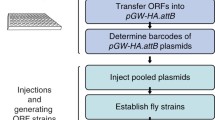Summary
I-R hybrid dysgenesis in Drosophila melanogaster occurs in female progeny of crosses between reactive strain females and inducer strain males, and is controlled by transposable elements called I-factors. These are 5.3 kb elements that are structurally similar to mammalian LINE elements and other retroposons. We have tested the activity of an I-factor directly, by introducing it into the genome of a reactive strain, using P-element mediated transformation. It confers the complete inducer phenotype on the reactive strain, and can stimulate dysgenesis when transformed males are mated with reactive females. It has transposed in the transformed lines, and we have cloned one of the transposed copies. This is the first time that it has been possible to demonstrate that a particular retroposon is transposition proficient, and to compare donor and transposed elements. We propose a mechanism for I-factor transposition based on these results, and the coding capacity of these elements. We have been unable to detect either autonomous transposition of a complete I-factor from a plasmid injected into reactive strain embryos, or transposition of a marked I-factor when co-injected with a complete element.
Similar content being viewed by others
References
Blackman RK, Grimaila R, Koehler MMD, Gelbart W (1987) Mobilization of hobo elements residing within the decapentaplegic gene complex: suggestion of a new hybrid dysgenesis system in Drosophila melanogaster. Cell 49:497–505
Bregliano JC, Kidwell MG (1983) Hybrid dysgenesis determinants. In: Shapiro J (ed) Mobile genetic elements. Academic Press, New York, pp 363–410
Bucheton A, Paro R, Sang HM, Pelisson A, Finnegan DJ (1984) The molecular basis of I-R hybrid dysgenesis: identification, cloning and properties of the I factor. Cell 38:153–163
Coté B, Bender W, Curtis D, Chovnick C (1986) Molecular mapping of the rosy locus in Drosophila melanogaster. Genetics 112:769–783
Engels WR (1988) P elements in Drosophila. In: Berg DE, Howe MM (eds) Mobile DNA. American Society for Microbiology, Washington
Fawcett DH, Lister CK, Kellett E, Finnegan DJ (1986) Transposable elements controlling I-R hybrid disgenesis in D. melanogaster are similar to mammalian LINEs. Cell 47:1007–1015
Feinberg P, Vogelstein B (1983) A technique for radiolabelling DNA restriction endonuclease fragments to high specific activity. Anal Biochem 132:6–13
Finnegan DJ (1988) The I factor and I-R hybrid dysgenesis in Drosophila melanogaster. In: Berg DE, Howe MM (eds) Mobile DNA. American Society for Microbiology, Washington
Gough JA, Murray NE (1983) Sequence diversity among related genes for recognition of specific targets in DNA molecules. J Mol Biol 166:1–19
Karess RE, Rubin GM (1984) Analysis of P transposable element functions in Drosophila. Cell 38:135–146
Lindsley D, Grell EH (1968) Genetic variation of Drosophila melanogaster. Carnegie Inst Wash Publ. No. 627
Murray NE (1983) Lambda vectors. In: Hendrix RW, Roberts JW, Stahl FW, Weisberg RA (eds) Lambda II. Cold Spring Harbor Laboratory, New York, Press, Cold Spring Harbor, pp 677–684
Murray NE, Brammar WJ, Murray K (1977) Lambdoid phages that simplify the recovery of in vitro recombinants. Mol Gen Genet 150:53–61
O'Hare K, Rubin GM (1983) Structures of P transposable elements and their sites of insertion and excision in the Drosophila melanogaster genome. Cell 34:25–35
Pardue ML (1986) In situ hybridisation to DNA of chromosomes and nuclei. In: Roberts DB (ed) Drosophila a practical approach. IRL Press, Oxford
Pelisson A (1981) The I-R system of hybrid dysgenesis in Drosophila melanogaster: are I factor insertions responsible for the mutator effect of the I-R interaction?. Mol Gen Genet 183:123–129
Pelisson A, Bregliano JC (1987) Evidence for rapid limitation of the I element copy number in a genome submitted to several generations of I-R hybrid disgenesis in Drosophila melanogaster. Mol Gen Genet 207:306–313
Picard G, Bregliano JC, Bucheton A, Lavige JM, Pelisson A, Kidwell MG (1978) Non-mendelian female sterility and hybrid dysgenesis in Drosophila melanogaster. Genet Res 32:275–287
Rubin GM, Spradling AC (1982) Genetic transformation of Drosophila with transposable element vectors. Science 218:348–353
Schwarz-Sommer Z, Leclercq L, Gobel F, Saedler H (1987) Cin4, an insert altering the structure of the A1 gene in Zea mays exhibits properties of nonviral retrotransposons. EMBO J 6:3873–3880
Spradling AC, Rubin GM (1982) Transposition of cloned P elements into Drosophila germ line chromosomes. Science 218:341–347
Steller H, Pirrotta V (1985) A transposable P vector that confers selectable G418 resistance on Drosophila larvae. EMBO J 4:167–171
Will BM, Bayev AA, Finnegan DJ (1981). Nucleotide sequence of terminal repeats of 412 transposable elements of Drosophila melanogaster. J Mol Biol 153:897–915
Yanisch-Perron C, Vieira J, Messing J (1985) Improved M13 phage cloning vectors and host strains: nucleotide sequence of the M13 mp18 and pUC19 vectors. Gene 33:103–109
Yannopoulus G, Stamatis N, Monastirioti M, Hatzopoulos P, Louis C (1987) Hobo is responsible for the induction of hybrid dysgenesis of Drosophila melanogaster bearing the male recombination factor 23.5MRF. Cell 49:487–495
Zalokar M (1981) A method for injection and transplantation of nuclei and cells in Drosophila eggs. Experientia 37:1354–1356
Author information
Authors and Affiliations
Additional information
Communicated by J.A. Campos-Ortega
Rights and permissions
About this article
Cite this article
Pritchard, M.A., Dura, JM., Pélisson, A. et al. A cloned I-factor is fully functional in Drosophila melanogaster . Mol Gen Genet 214, 533–540 (1988). https://doi.org/10.1007/BF00330491
Received:
Issue Date:
DOI: https://doi.org/10.1007/BF00330491




